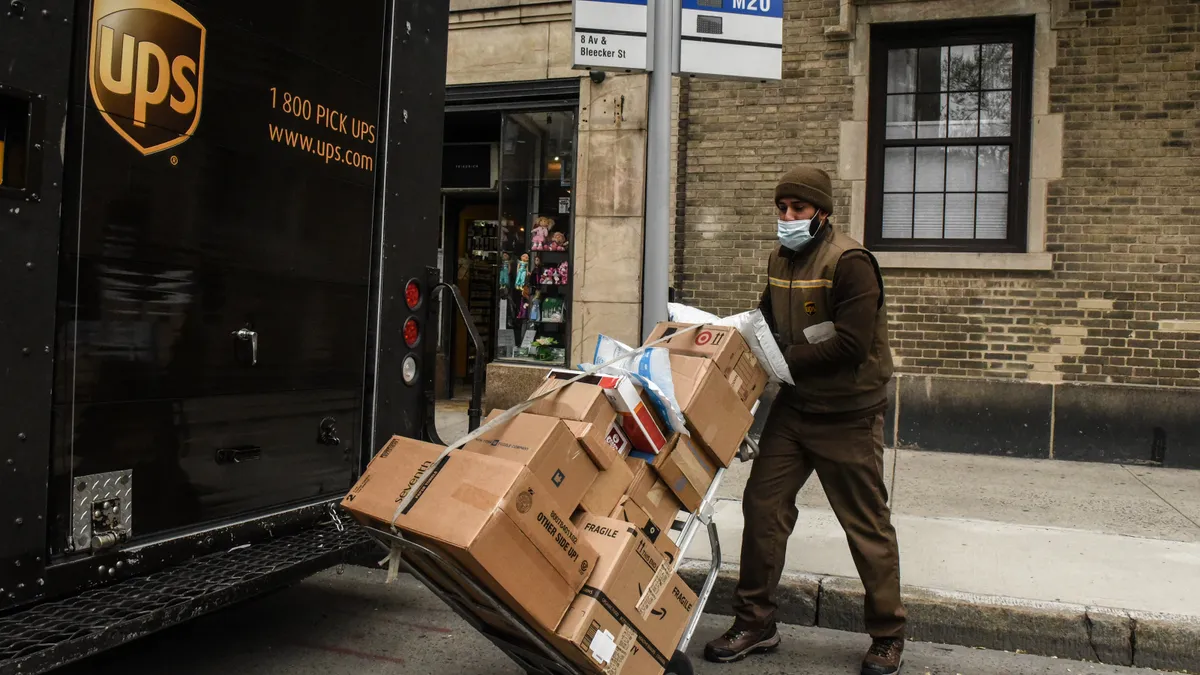Dive Brief:
- UPS is expected to complete the rollout of an upgrade to its On-Road Integrated Optimization and Navigation technology, known as ORION, in July, Chief Information and Engineering Officer Juan Perez said during the company's investor day this week.
- The upgrade, called "dynamic ORION," has enabled the company to reduce driver routes by an average of two to four miles per driver, Perez said, adding that the original ORION implementation resulted in a reduction of eight miles per driver. The new system is already being used by 97% of the van fleet that uses ORION.
- "The new features present our drivers with reoptimized routes based on changing conditions and provide them turn-by-turn directions to reduce excess miles," he said.
Dive Insight:
Logistics companies have become more interested in route planning as packages pour into their networks. Volume surges have prompted them to figure out the most efficient way to get them delivered to their final destination. For UPS, it's work that is decades in the making.
UPS tested its ORION algorithm between 2003 and 2009, with pilot testing taking place in eight locations between 2010 and 2011, according to the company.
The dynamic routing upgrade that is now rolling out began to be deployed in the fall of last year, between September and October, according to Matthew O'Connor, a UPS spokesperson.
In the previous versions of ORION, the driver's routes would be downloaded to their handheld computer — known as the Delivery Information Acquisition Device — before they left the facility for the day. Now, the dynamic routing allows for these routes to be updated throughout the day automatically.
"So, if we've got a request for a pickup that comes in, you don't have to have a supervisor call the driver to say, 'Hey, can you please include this pickup,'" O'Connor said. The dynamic routing will automatically add the pickup and change the route to include it in the most efficient way possible.
Amazon is also looking for upgrades to its routing algorithm and is using a competition and the promise of a $100,000 prize to get some outside assistance. Amazon specifically wants to figure out a way for algorithms to pick up on the learned knowledge of a delivery driver, such as where to park and the best way to avoid traffic in particular neighborhoods.
"Cities especially are becoming ever more complex to actually operate in," Matthias Winkenbach, director of Massachusetts Institute of Technology's Megacity Logistics Lab, said in February, talking about the Amazon competition. "They're getting more congested, they're getting denser, just getting more and more difficult to efficiently deliver goods in the city." Amazon partnered with MIT for the competition.
Cost savings are a big reason why companies turn to route-planning tools: Driving less means less fuel consumption. But companies often highlight the investment by underscoring its benefits in terms of sustainability.
"It just follows on naturally that, if you decrease the amount of miles, you decrease the amount of fuel burned and, therefore, the carbon. The incentives are perfectly aligned with respect to saving costs and being greener," Neil Menzies, a managing director at L.E.K. Consulting, said earlier this year.
But the planning considerations for UPS go beyond the final-mile routing offered by ORION. UPS is also working to realize efficiencies before packages make it to delivery trucks, with its Network Planning Tools and its Harmonized Enterprise Analytic Tool. The analytics tool connects multiple data sources and allows it to see how packages are flowing through its facilities, O'Connor said.
"It basically enabled us to create a digital twin of real-time package flow," he said.
The tool looks at variables like the package's size, type and final locations. And, similar to the routing done by ORION, it figures out the most efficient way for it to move from point A to point B through UPS' facilities.
Perez noted that the benefits of this kind of routing were evident when the country was hit by a severe winter storm in February.
"[Network Planning Tools] helped us minimize network disruptions by applying advanced analytics to help us route volume around the impacted areas, adjust to volume shifts, and ensure that we provided capacity where it was ultimately needed," he said.
If roads are impassable then the system will reroute packages through the network to avoid those areas, O'Connor explained.
UPS plans to make more upgrades to its Network Planning Tools platform later this year with improved movement and scheduling optimization capabilities.
The logistics company is working to squeeze extra efficiency out of its network at a time when it is increasing demand. It expects the average daily volume to grow by nearly 20% between 2020 and 2023, CEO Carol Tomé said this week.
"We anticipate globally demand for small package services to outpace capacity in the industry for the next several years," Tomé said.
She outlined other efforts, including investments in automation and weekend delivery that "adds capacity without adding capital investment." Using data analysis to shave away at miles driven seems to sit squarely in that strategy, as well.














